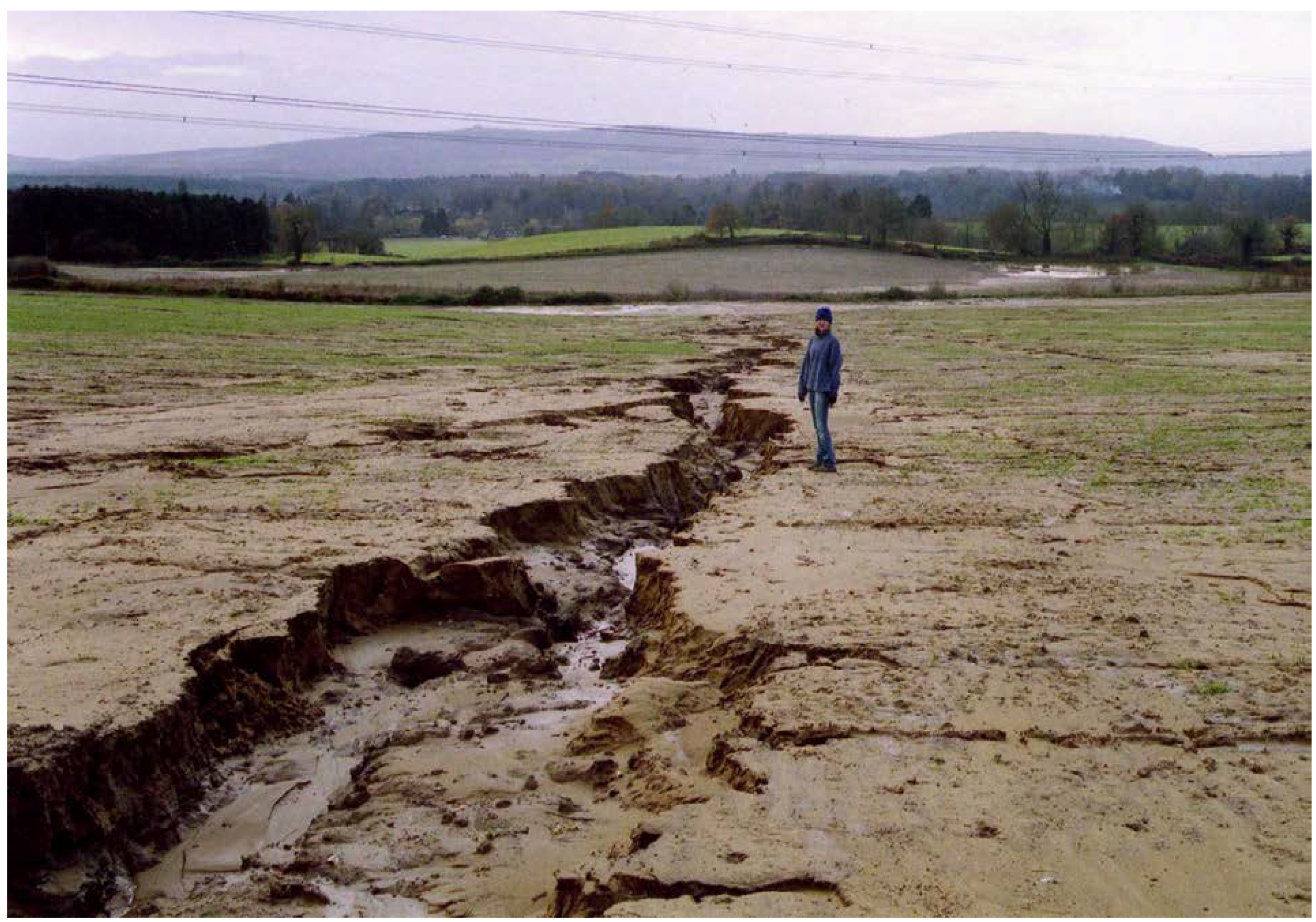Soil Erosion in Britain: Updating the Record
Abstract
:1. Introduction
| Average annual soil losses in the Silsoe area, Bedfordshire (t/ha) | |
|---|---|
| Bare sandy loam soil | 10–45 |
| Cereals on sandy loam soil | 0.6–24 |
| Cereals on chalky soil | 0.6–21 |
| Cereals on clay soil | 0.3–0.7 |
| Grass on sandy loam soil | 0.1–3 |
| Woodland on sandy loam soil | −0.01 |
2. Historical Erosion
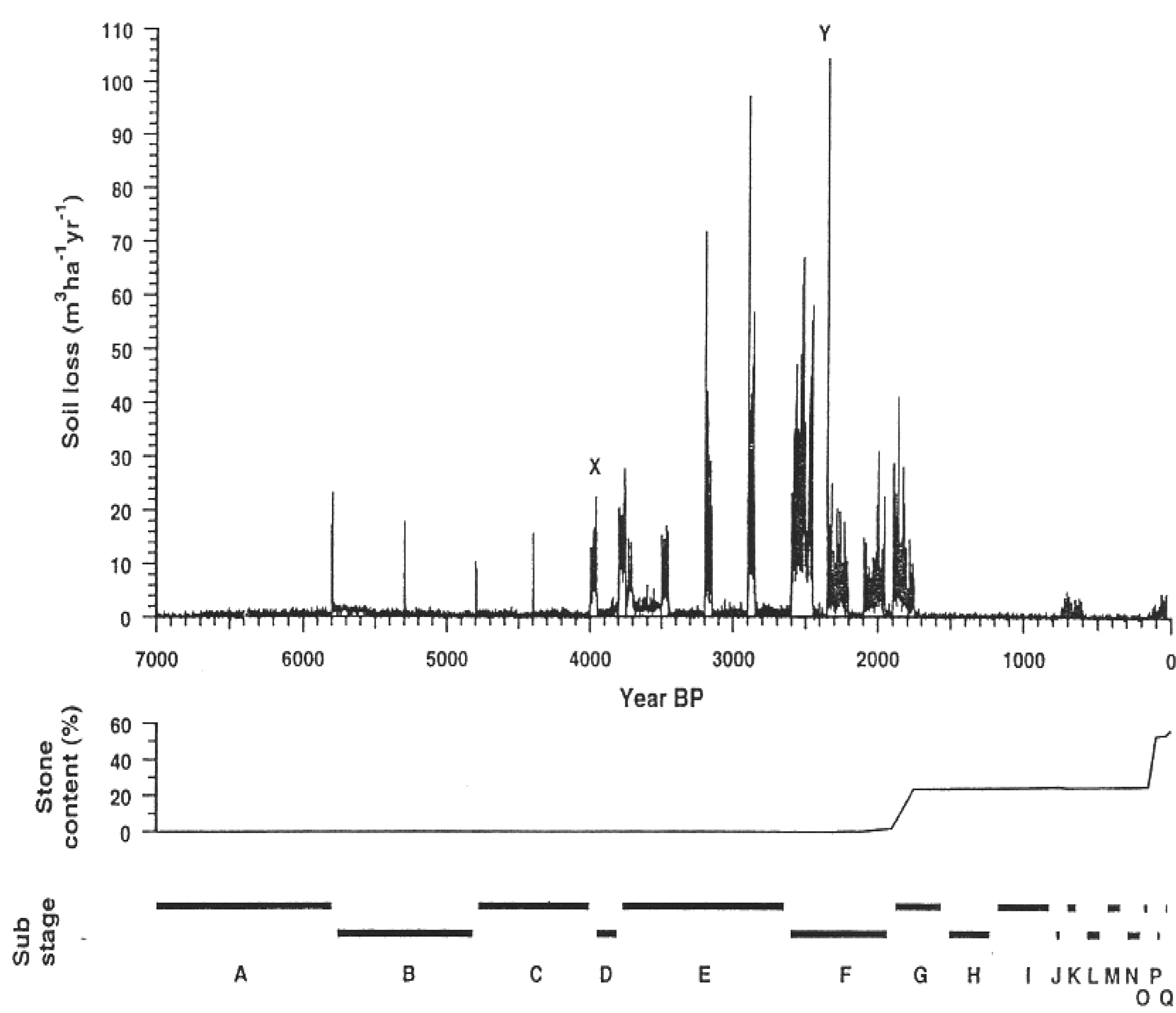
3. Current Erosion in Britain
3.1. Assessment of Erosion
- East Shropshire: 600 sites of erosion 1967–1976 in east Shropshire [9];
- Albourne, West Sussex: erosion on strawberry crop on Lower Greensand soil [48];
- South Somerset: survey of 40 fields in winter of 1982–1983 [49];
- West Midlands: major summer storm on recently planted oil-seed rape fields [53];
- East Kent: erosion on loessic soils [56].
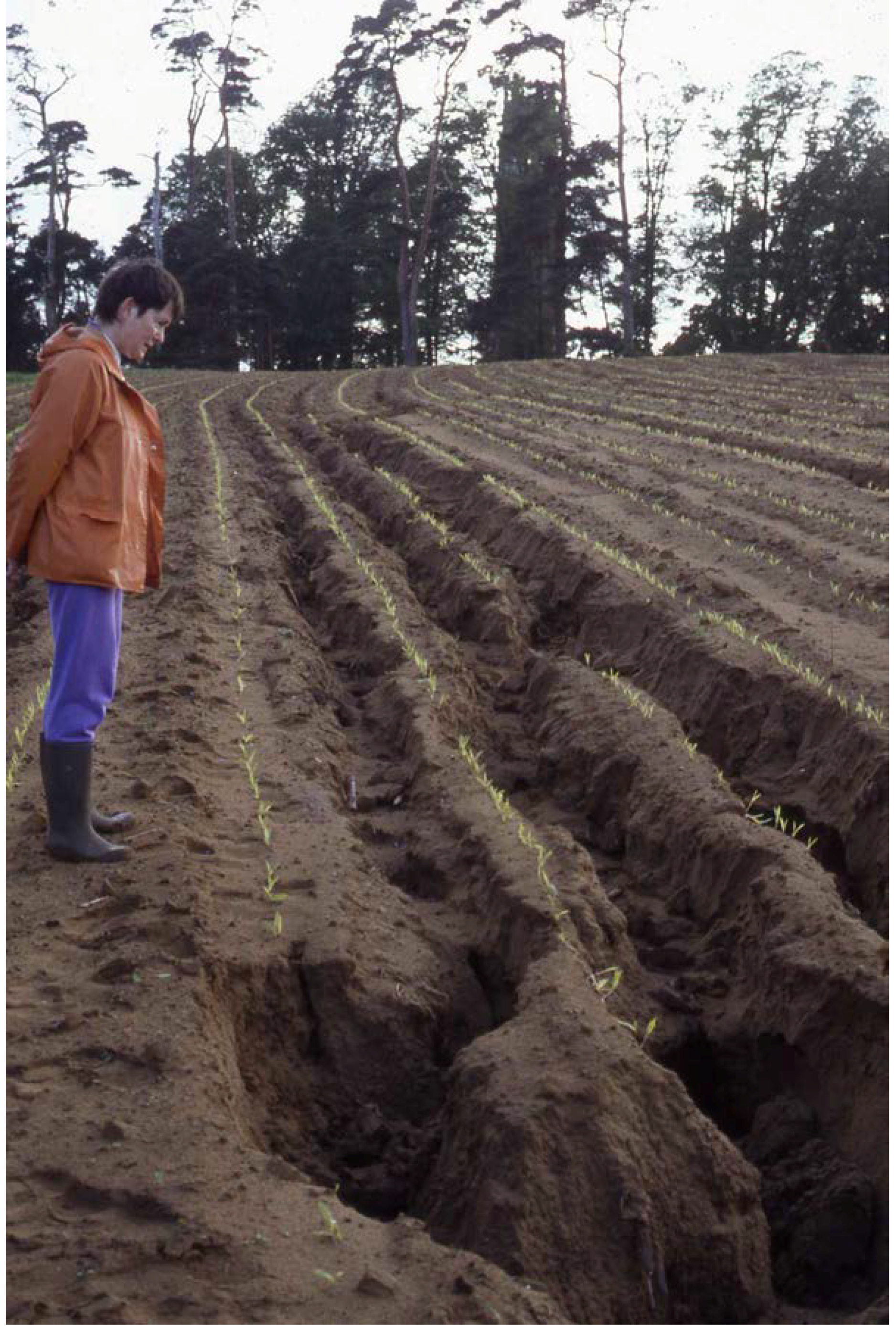
3.2. Causes of Erosion
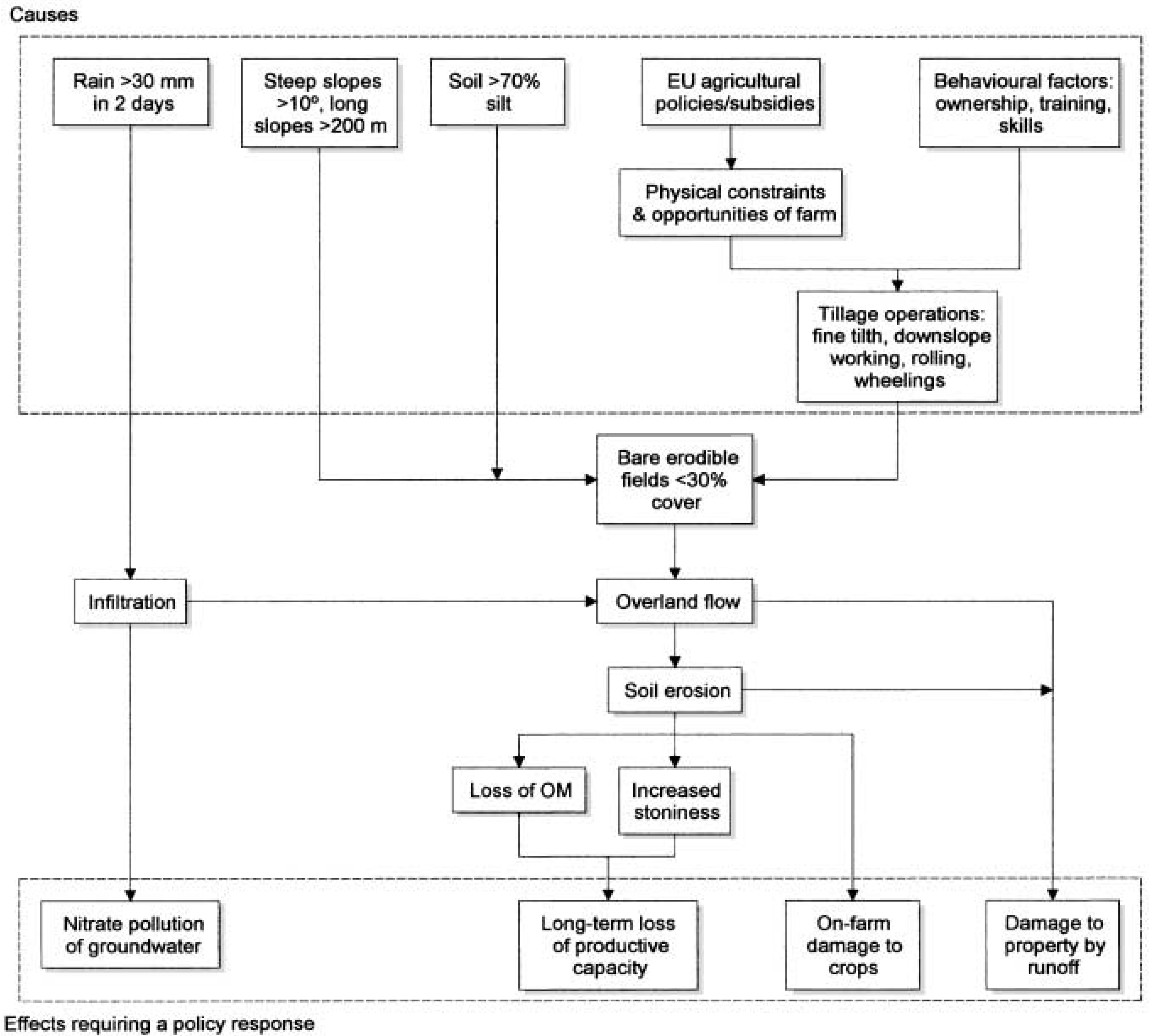
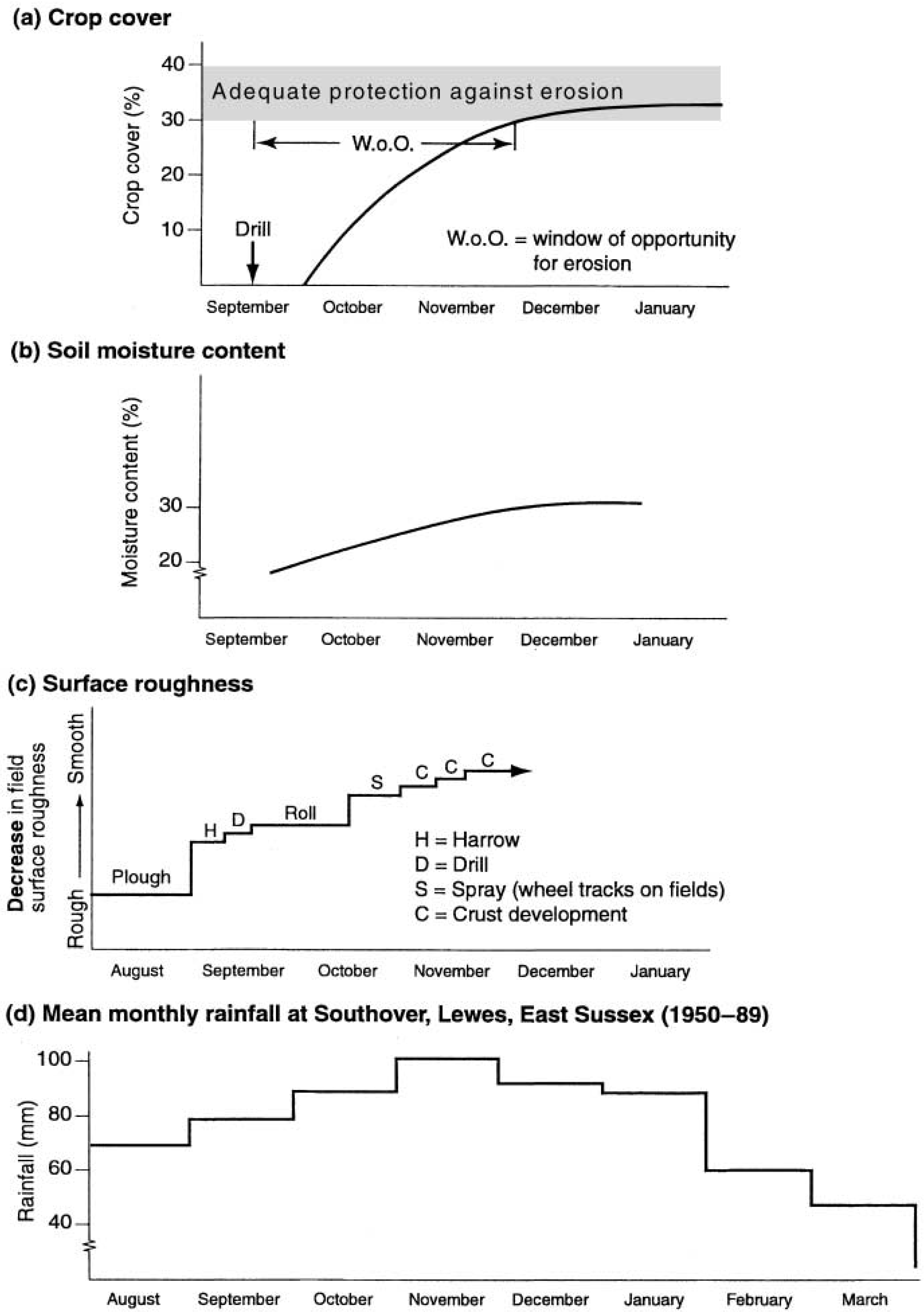
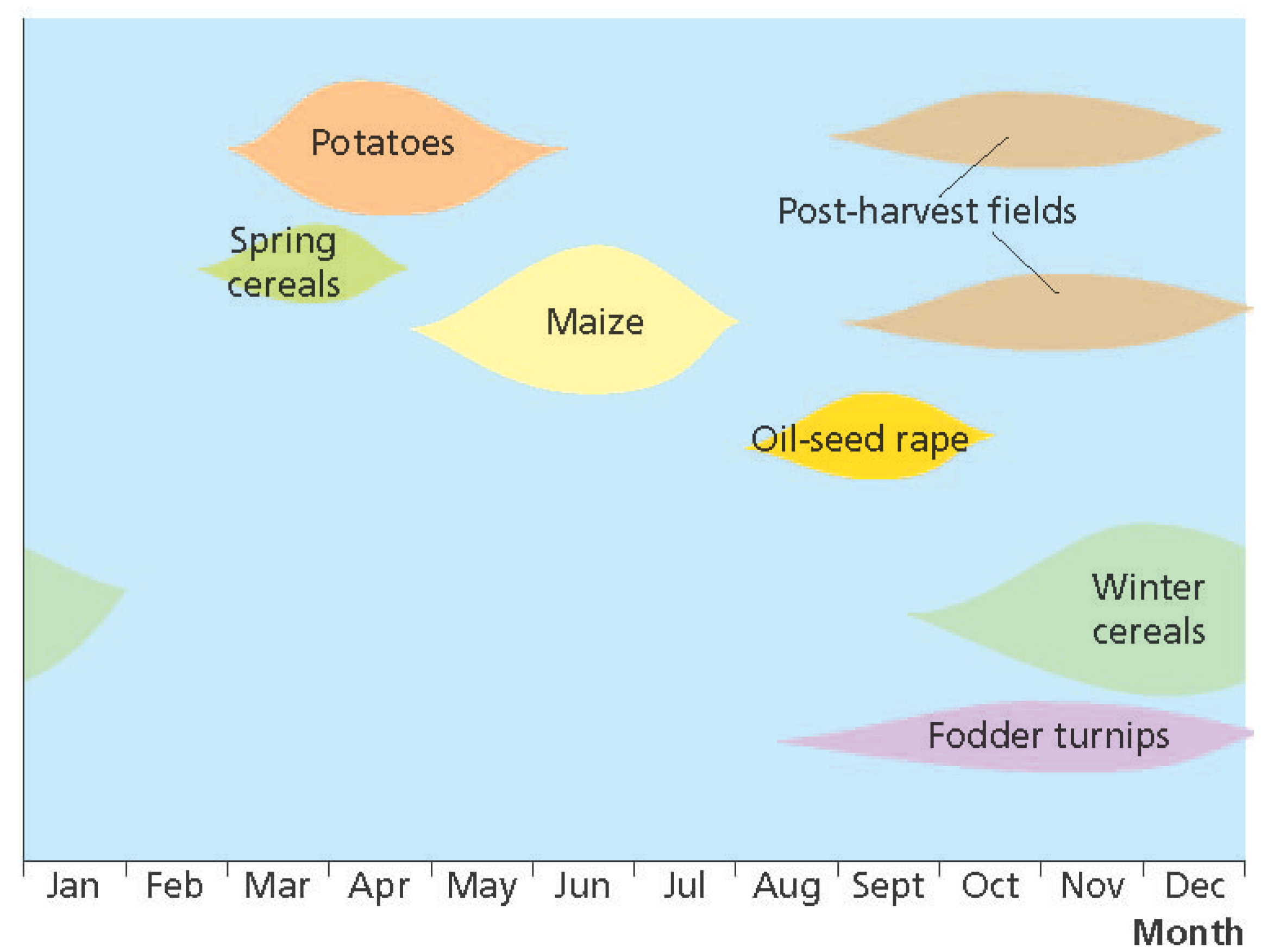
| Land-use | % organic carbon(8 random samples from within each land-use block) | Mean | |||||||
|---|---|---|---|---|---|---|---|---|---|
| Woodland-scrub | 6.5 | 6.4 | 6.0 | 6.2 | 6.0 | 6.5 | 6.3 | 6.3 | 6.3 |
| Permanent grassland | 12.4 | 12.0 | 11.9 | 12.2 | 11.4 | 11.8 | 11.6 | 12.2 | 11.9 |
| Converted to arable post1978 | 10.5 | 11.2 | 9.8 | 11.1 | 11.0 | 10.9 | 8.6 | 10.9 | 10.5 |
| Converted to arable 1955–1978 | 5.6 | 5.7 | 4.9 | 5.3 | 5.0 | 5.5 | 6.0 | 5.6 | 5.5 |
| Arable pre1945 | 3.4 | 2.5 | 3.2 | 3.1 | 2.5 | 3.3 | 3.1 | 3.8 | 3.1 |
3.3. Where is Erosion Occurring?
- Red sandstone soils of the East and West Midlands and south Devon e.g., areas around Retford (Nottinghamshire), Bridgnorth (Shropshire) and Dawlish (Devon); cases of both water and wind erosion are recorded in these areas (Figure 6).
- Chalklands of southern England: not because of the inherent erodibility of the soils but because of large areas under winter cereals, large fields and compaction along wheelings (Figure 7).
- Lower Greensand soils of Bedfordshire, West Sussex and the Isle of Wight which tend to be intensively farmed with crops such as potatoes, maize, vegetables and some cereals (Figure 8).
- Silty and fine sandy soils in Somerset e.g., on the Bridport Sands around Yeovil.
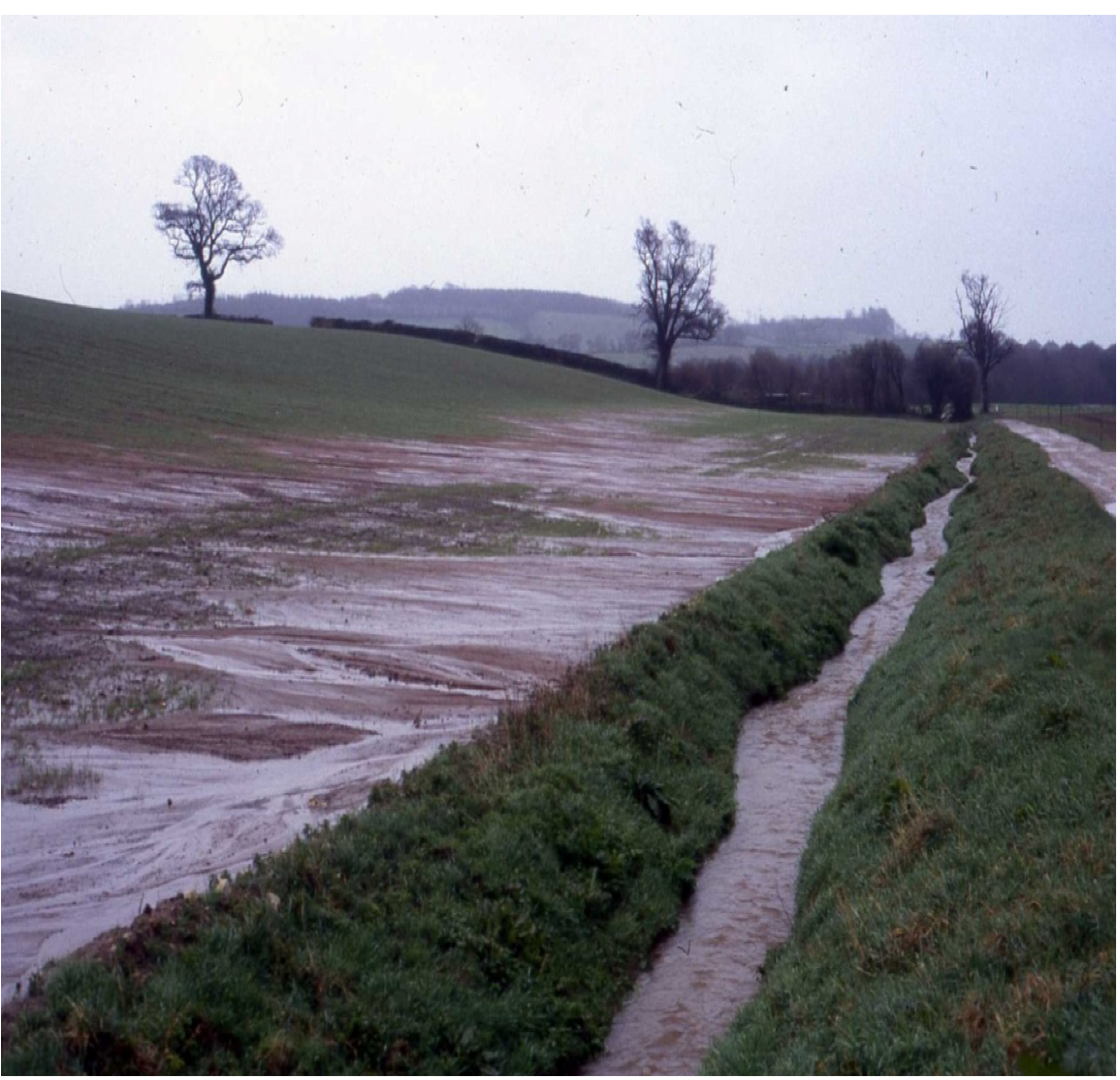
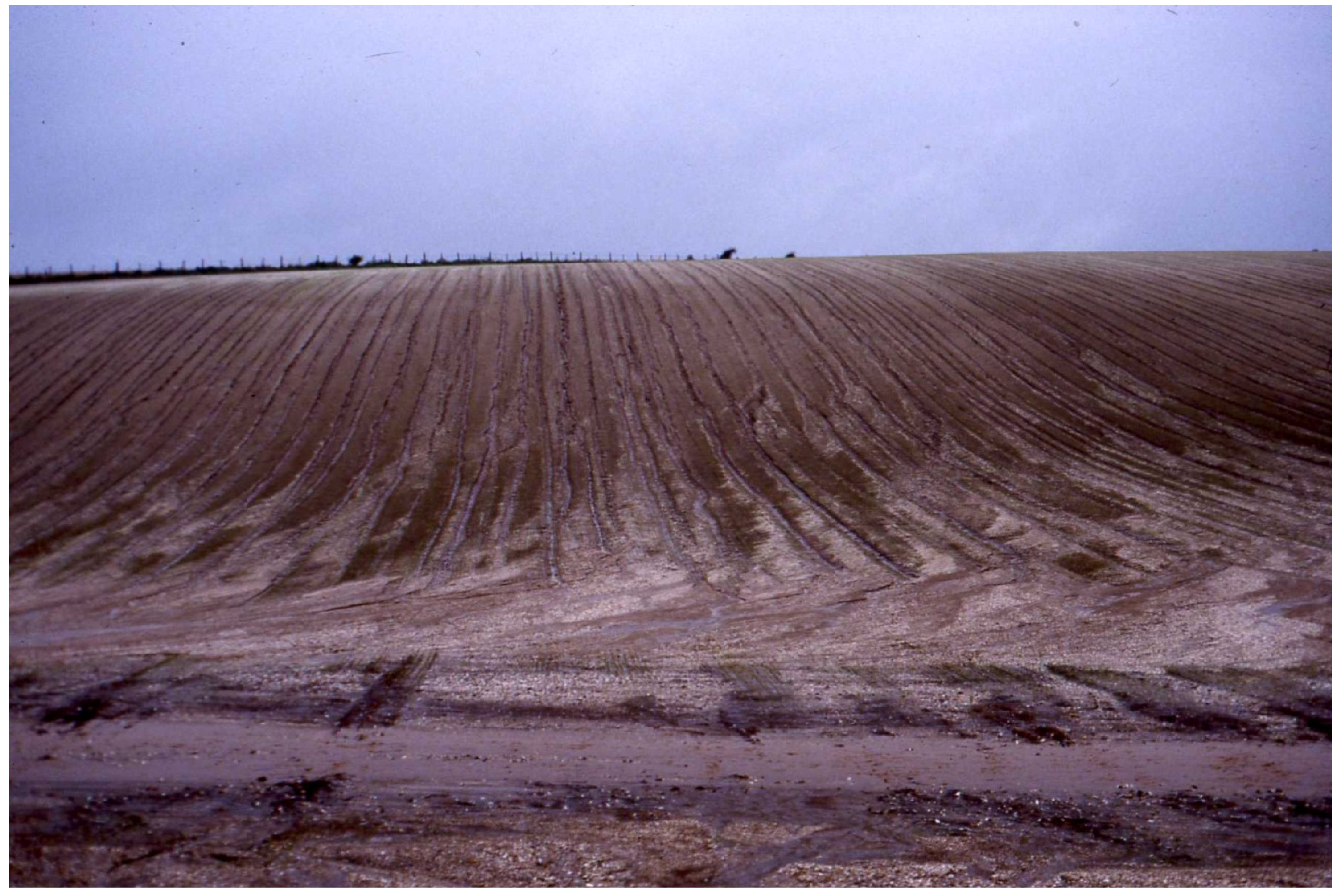
| Crop | No. eroded fields | Mean rate(m3/ha) | Median rate(m3/ha) | national crop area (%) |
|---|---|---|---|---|
| Market garden & vegetables | 102 | 5.08 | 1.47 | 3.1 |
| Maize | 26 | 4.48 | 1.00 | 0.4 |
| Ley Grass | 68 | 4.09 | 1.14 | 4.8 |
| Hops | 8 | 3.92 | 1.01 | 0.1 |
| Sugar beet | 296 | 3.04 | 0.92 | 4.4 |
| Otder 2 | 49 | 2.67 | 1.07 | 1.1 |
| Potatoes | 171 | 2.53 | 1.01 | 3.2 |
| Kale & otder fodder crops | 12 | 2.10 | 1.41 | 0.6 |
| Oilseed rape | 25 | 1.92 | 0.30 | 5.2 |
| Winter cereals 3 | 689 | 1.85 | 0.68 | 60.2 |
| Spring cereals 4 | 186 | 1.75 | 0.71 | 13.6 |
| Bare soil/fallow 5 | 25 | 1.61 | 0.27 | 1.1 |
| Peas | 16 | 1.21 | 0.91 | 1.3 |
| Field beans | 6 | 0.47 | 0.22 | 0.9 |
3.4. Rates of Erosion
| Locality | Erosion (m3 ha−1) | Soil association | Erosion (m3 ha−1) | Topsoil texture | ||||
|---|---|---|---|---|---|---|---|---|
| Median | Mean | No | Median | Mean | No | |||
| Bedfordshire | 0.31 | 0.47 | 65 | 411d Hanslope | 0.29 | 0.58 | 49 | Clayey |
| Cumbria | 0.36 | 1.50 | 34 | - | - | - | - | - |
| Devon | 1.22 | 1.51 | 19 | - | - | - | - | - |
| Dorset | 0.81 | 1.35 | 92 | 411b Evesham 2 | 0.74 | 1.41 | 63 | Clayey |
| Gwent | 0.83 | 1.43 | 73 | 571b Bromyard | 0.80 | 1.29 | 31 | Fine silty |
| 541a Milford | 0.79 | 2.08 | 35 | Fine loamy | ||||
| Hampshire | 1.33 | 3.95 | 59 | 571i Harwell | 1.30 | 3.52 | 55 | Loamy |
| Herefordshire | 0.68 | 1.20 | 89 | 571b Bromyard | 0.67 | 1.40 | 68 | Fine silty |
| Isle of Wight | 1.52 | 4.39 | 141 | 571g Fyfield 4 | 1.62 | 5.54 | 128 | Coarse loamy+sandy |
| Kent | 3.58 | 4.82 | 41 | - | - | - | - | - |
| Norfolk East | 0.76 | 1.03 | 118 | 551g Newport 4 | 0.50 | 1.10 | 40 | Sandy |
| 541t Wick 3 | 0.38 | 1.05 | 63 | Coarse loamy | ||||
| Norfolk West | 0.25 | 0.85 | 110 | 343g Newmarket 2 | 0.58 | 112 | 60 | Coarse loamy+sandy |
| 581f Barrow | 0.19 | 0.92 | 45 | Coarse loamy | ||||
| Nottinghamshire | 0.71 | 1.49 | 209 | 551b Cuckney 1 | 0.72 | 2.32 | 191 | Sandy+coarse loamy |
| Shropshire | 0.90 | 2.36 | 197 | 572m Salwick | 1.25 | 3.33 | 36 | Fine loamy |
| 551d Newport 1 | 0.97 | 2.55 | 38 | Sandy+coarse loamy | ||||
| 551a Bridgnortd | 0.96 | 2.76 | 94 | Sandy+coarse loamy | ||||
| Somerset | 2.55 | 4.69 | 161 | 541m S. Petderton | 2.10 | 4.76 | 114 | Silty |
| 572i Curtisden | 1.39 | 2.58 | 30 | Silty | ||||
| Staffordshire | 0.82 | 2.43 | 205 | 551a Bridgnortd | 1.06 | 3.15 | 100 | Sandy+coarse loamy |
| 551g Newport 4 | 0.66 | 2.60 | 53 | Sandy | ||||
| Sussex East | 0.32 | 0.62 | 30 | - | - | - | - | - |
| Sussex West | 0.29 | 0.80 | 62 | 343h Andover 1 | 0.37 | 1.02 | 32 | Silty |
4. Impacts of Erosion
4.1. On-Site Impacts
| Median soil loss (m³ ha−1) | Total soil loss (m³) | Number of sites | |
|---|---|---|---|
| 82–83 | 1.7 | 1816 | 68 |
| 83–84 | 0.6 | 27 | 7 |
| 84–85 | 1.1 | 182 | 25 |
| 85–86 | 0.7 | 541 | 49 |
| 86–87 | 0.7 | 211 | 34 |
| 87–88 | 5.0 | 13529 | 97 |
| 88–89 | 0.5 | 2 | 1 |
| 89–90 | 1.4 | 940 | 51 |
| 90–91 | 2.3 | 1527 | 43 |
| 91–92 | 1.2 | 112 | 14 |
4.2. Off-Site Effects of Soil Erosion
5. Measures to Prevent Erosion and off-Site Impacts
6. The Future
7. Conclusions
Acknowledgements
Conflicts of Interest
References
- Bergsma, E. Terminology for Soil Erosion and Conservation. In Presented at International Society for Soil Science, Wageningen, The Netherlands, 1996.
- Govers, G.; Poesen, J. Assessment of the interrill and rill contributions to total soil loss from an upland field plot. Geomorphology 1988, 1, 343–354. [Google Scholar] [CrossRef]
- Evans, R.; McLaren, D. Soil Erosion and Its Impacts in England and Wales; Friends of the Earth: London, UK, 1996; p. 31. [Google Scholar]
- Ruysschaert, G.; Poesen, J.; Verstraeten, G.; Govers, G. Soil losses due to crop harvesting in Europe. In Soil Erosion in Europe; Boardman, J., Poesen, J., Eds.; Wiley: Chichester, UK, 2006; pp. 609–621. [Google Scholar]
- Van Oost, K.; Govers, G. Tillage erosion. In Soil Erosion in Europe; Boardman, J., Poesen, J., Eds.; Wiley: Chichester, UK, 2006; pp. 599–608. [Google Scholar]
- Evans, R. The need for soil conservation. Area 1971, 3, 20–23. [Google Scholar]
- Boardman, J. The need for soil conservation in Britain—Revisited. Area 2002, 34, 419–427. [Google Scholar]
- Evans, R. Monitoring water erosion in lowland England and Wales—A personal view of its history and outcomes. Catena 2005, 64, 142–161. [Google Scholar] [CrossRef]
- Reed, A.H. Accelerated erosion of arable soils in the United Kingdom by rainfall and run-off. Outlook Agric. 1979, 10, 41–48. [Google Scholar]
- Morgan, R.P.C. Soil erosion in the United Kingdom: field studies in the Silsoe area 1973–75. In Occasional Paper, No. 4; National College of Agricultural Engineering: Cranfield, UK, 1977. [Google Scholar]
- Morgan, R.P.C. Soil erosion and conservation in Britain. Prog. Phy. Geog. 1980, 4, 24–47. [Google Scholar] [CrossRef]
- Stammers, R.; Boardman, J. Soil erosion and flooding on downland areas. Surveyor 1984, 164, 8–11. [Google Scholar]
- Evans, R.; McLaren, D. Soil Erosion and Its Impacts in England and Wales; Friends of the Earth: London, UK, 1996; p. 121. [Google Scholar]
- Boardman, J.; Evans, R. Soil Erosion in Britain: A Review. In Conserving Soil Resources: European Perspectives; Rickson, R.J., Ed.; CAB International: Wallingford, UK, 1994; pp. 3–12. [Google Scholar]
- Boardman, J.; Evans, R. Britain. In Soil Erosion in Europe; Boardman, J., Poesen, J., Eds.; Wiley: Chichester, UK, 2006; pp. 439–453. [Google Scholar]
- Boardman, J. The Sensitivity of Downland Arable Land to Erosion by Water. In Environmental Sensitivity; Thomas, D.S.G., Allison, R.J., Eds.; Wiley: Chichester, UK, 1993; pp. 211–228. [Google Scholar]
- Evans, R. Towards sustainable land management in Britain. Landwards 2013, Spring, 16–17. [Google Scholar]
- Evans, R.; Boardman, J. The curtailment of flooding in the Sompting catchment. Soil Use Man. 2003, 19, 223–231. [Google Scholar] [CrossRef]
- Favis-Mortlock, D.T.; Boardman, J.; Bell, M. Modelling long-term anthropogenic erosion of a loess cover, South Downs, UK. Holocene 1997, 7, 79–89. [Google Scholar] [CrossRef]
- Evans, R. Sensitivity of British Landscape to Erosion. In Environmental Sensitivity; Thomas, D.S.G., Allison, R.J., Eds.; Wiley: Chichester, UK, 1993; pp. 189–210. [Google Scholar]
- Morgan, R.P.C. Soil erosion in Britain: The loss of a resource. Ecologist 1986, 16, 40–41. [Google Scholar]
- Evans, R. Land Use and Accelerated Soil Erosion by Water in a Small catchment on the South Downs, West Sussex, England—Past and Present. In Landscapes Through the Lens; Cowley, D.C., Standring, R.A., Abicht, M.J., Eds.; Oxbow Books: Oxford, UK, 2010; pp. 129–142. [Google Scholar]
- Bell, M.; Boardman, J. Past and Present Soil Erosion: Archaeological and Geographical Perspectives; Oxbow Monograph 22; Oxbow Books: Oxford, UK, 1992. [Google Scholar]
- Bell, M. The Effects of Land-Use and Climate on Valley Sedimentation. In Climate Change in Later Prehistory; Harding, A.F., Ed.; Edinburgh University Press: Edinburgh, UK, 1982; pp. 127–142. [Google Scholar]
- Vita-Finzi, C. The Mediterranean Valleys: Geological Changes in Historical Times; Cambridge University Press: Cambridge, UK, 1969. [Google Scholar]
- Pennington, W. Vegetation History in the North West of England: A Regional Synthesis. In Studies in the Vegetational History of the British Isles; Walker, D., West, R.G., Eds.; Cambridge University Press: Cambridge, UK, 1970; pp. 41–79. [Google Scholar]
- Jones, R.; Benson-Evans, K.; Chambers, F.M. Human influence upon sedimentation in Llangorse Lake, Wales. Earth Surf. Proc. Land. 1985, 10, 227–235. [Google Scholar] [CrossRef]
- Harvey, A.M.; Oldfield, F.; Baron, A.F. Dating of post-glacial landforms in the central Howgills. Earth Surf. Proc. Land. 1981, 6, 401–412. [Google Scholar] [CrossRef]
- Evans, R. Erosion in England and Wales—The Present is the Key to the Past. In Past and Present Soil Erosion: Archaeological and Geographical Perspectives; Oxbow Monograph 22; Bell, M., Boardman, J., Eds.; Oxbow Books: Oxford, UK, 1992; pp. 53–66. [Google Scholar]
- Evans, R. Soil erosion in the UK initiated by grazing animals. Appl. Geog. 1997, 17, 127–141. [Google Scholar] [CrossRef]
- Evans, R. Soil Erosion: Its Impact on the English and Welsh Landscape since Woodland Clearance. In Soil Erosion on Agricultural Land; Boardman, J., Foster, I.D.L., Eds.; Wiley: Chichester, UK, 1990; pp. 231–254. [Google Scholar]
- Boardman, J. Soil Erosion: The Challenge of Assessing Variation through Space and Time. In Geomorphological Variations; Goudie, A.S., Kalvoda, J., Eds.; Nakladatelsti P3K: Prague, Czech Republic, 2007; pp. 205–220. [Google Scholar]
- Evans, R.; Brazier, R. Evaluation of modelled spatially distributed predictions of soil erosion by water versus field-based assessments. Environ. Sci. Pol. 2005, 8, 493–501. [Google Scholar] [CrossRef]
- Quine, T.A.; Walling, D.E. Rates of soil erosion on arable fields in Britain: Quantitative data from caesium-137 measurements. Soil Use Man. 1991, 7, 169–176. [Google Scholar] [CrossRef]
- Walling, D.E.; Quine, T.A. Use of 137Cs measurements to investigate soil erosion on arable fields in the UK: Potential applications and limitations. J. Soil Sci. 1991, 42, 147–165. [Google Scholar] [CrossRef]
- Quine, T.A.; Walling, D.E. In Farm Land Erosion: In Temperate Plains Environment and Hills; Wicherek, S., Ed.; Elsevier: Amsterdam, The Netherlands, 1993; pp. 357–371. [Google Scholar]
- Parsons, A.J.; Foster, I.D.L. What can we learn about soil erosion from the use of 137Cs? Earth Sci. Rev. 2011, 108, 101–113. [Google Scholar] [CrossRef]
- Evans, R. Assessing erosion in England and Wales. In Proceedings of the 7th ISCO ConferenceInternational Soil Conservation Organisation, Sydney, Australia, 27–30 September 1992; pp. 82–91.
- Evans, R. Extent, Frequency and Rates of Rilling of Arable Land in Localities in England and Wales. In Temperate Plains Environments and Hills; Wicherek, S., Ed.; Elsevier: Amsterdam, The Netherlands, 1993; pp. 177–190. [Google Scholar]
- Evans, R.; Boardman, J. Assessment of Water Erosion in Farmers’ Fields in the UK. In Conserving Soil Resources: European Perspectives; Rickson, R.J., Ed.; CABI: Wallingford, UK, 1994; pp. 13–24. [Google Scholar]
- Chambers, B.J.; Davies, D.B.; Holmes, S. Monitoring of water erosion on arable farms in England and Wales, 1989–90. Soil Use Man. 1992, 8, 163–170. [Google Scholar] [CrossRef]
- Chambers, B.J.; Garwood, T.W.D. Monitoring of water erosion on arable farms in England and Wales, 1990–94. Soil Use Man. 2000, 16, 93–99. [Google Scholar] [CrossRef]
- Boardman, J. Soil erosion and flooding on the eastern South Downs, southern England, 1976–2001. Trans. Inst. Brit. Geog. NS 2003, 28, 176–196. [Google Scholar] [CrossRef]
- Prasuhn, V. Soil erosion in the Swiss midlands: Results of a 10 year field survey. Geomorphology 2011, 126, 32–41. [Google Scholar] [CrossRef]
- Prasuhn, V. On-farm effects of tillage and crops on soil erosion measured over 10 years in Switzerland. Soil Till. Res. 2012, 120, 137–146. [Google Scholar] [CrossRef]
- Evans, R.; Nortcliff, S. Soil erosion in north Norfolk. J. Agric. Sci. Camb. 1978, 90, 185–192. [Google Scholar] [CrossRef]
- Evans, R. Curtailing water erosion of cultivated land: An example from north Norfolk, eastern England. Earth Surf. Proc. Land. 2006, 31, 598–605. [Google Scholar] [CrossRef]
- Boardman, J. Soil erosion at Albourne, West Sussex, England. Appl. Geog. 1983, 3, 317–329. [Google Scholar] [CrossRef]
- Colborne, G.J.N.; Staines, S.J. Soil erosion in south Somerset. J. Agric. Sci. Camb. 1985, 104, 107–112. [Google Scholar] [CrossRef]
- Boardman, J. Severe erosion on agricultural land in East Sussex, UK October 1987. Soil Tech. 1988, 1, 333–348. [Google Scholar] [CrossRef]
- Boardman, J. Storms, floods and soil erosion on the South Downs, East Sussex, autumn and winter 2000–01. Geography 2001, 84, 346–355. [Google Scholar]
- Boardman, J.; Burt, T.; Evans, R.; Slattery, M.C.; Shuttleworth, H. Soil erosion and flooding as a result of a summer thunderstorm in Oxfordshire and Berkshire, May 1993. Appl. Geog. 1996, 16, 21–34. [Google Scholar] [CrossRef]
- Foster, I.D.L.; Harrison, S.; Clark, D. Soil erosion in the West Midlands. Geography 1997, 82, 231–239. [Google Scholar]
- Watson, A.; Evans, R. A comparison of estimates of soil erosion made in the field and from photographs. Soil Till. Res. 1991, 19, 17–27. [Google Scholar] [CrossRef]
- Watson, A.; Evans, R. Water erosion of arable fields in north-east Scotland, 1985–2007. Scott. Geog. J. 2007, 123, 107–121. [Google Scholar] [CrossRef]
- Boardman, J.; Hazelden, J. Examples of erosion on brickearth soils in east Kent. Soil Use Man. 1986, 2, 105–108. [Google Scholar] [CrossRef]
- Evans, R. Overgrazing and soil erosion on hill pastures with particular reference to the Peak District. J. Brit. Grass. Soc. 1977, 32, 65–76. [Google Scholar] [CrossRef]
- Evans, R. The erosional impacts of grazing animals. Prog. Phy. Geog. 1998, 22, 251–268. [Google Scholar]
- Royal Commission on Environmental Pollution, Sustainable Use of Soil; Report No 19; Her Majesty’s Stationery Office: London, UK, 1996.
- McHugh, M.; Harrod, T.; Morgan, R. The extent of soil erosion in upland England and Wales. Earth Surf. Proc. Land. 2002, 27, 99–107. [Google Scholar] [CrossRef]
- McHugh, M. Short-term changes in upland soil erosion in England and Wales: 1999 to 2002. Geomorphology 2007, 86, 204–213. [Google Scholar] [CrossRef]
- Grieve, I.C.; Hipkin, J.A.; Davidson, D.A. Soil Erosion Sensitivity in Upland Scotland; Report No 24; Scottish Natural Heritage Research Survey and Monitoring Report: Edinburgh UK, 1994. [Google Scholar]
- Grieve, I.C.; Davidson, D.A.; Gordon, J.E. Nature, extent and severity of soil erosion in upland Scotland. Land Deg. Rehab. 1995, 6, 41–55. [Google Scholar] [CrossRef]
- Boardman, J.; Poesen, J.; Evans, R. Socio-economic factors in soil erosion and conservation. Environ. Sci. Pol. 2003, 6, 1–6. [Google Scholar] [CrossRef]
- Boardman, J.; Shepheard, M.; Walker, E.; Foster, I.D.L. Soil erosion and risk assessment for on- and off-farm impacts: A test case in the Midhurst area, West Sussex, UK. J. Environ. Man. 2009, 90, 2578–2588. [Google Scholar] [CrossRef]
- Controlling Soil Erosion; Department for Environment, Food and Rural Affairs: London, UK, 2005.
- Boardman, J. Soil erosion and farming: Assessing the risk. Geog. Rev. 2012, 26, 36–40. [Google Scholar]
- Papy, F.; Boiffin, J. The use of farming systems for the control of runoff and erosion. Soil Technol. 1989, 1, 29–38. [Google Scholar]
- Speirs, R.B.; Frost, C.A. The increasing incidence of accelerated soil water erosion on arable land in the east of Scotland. Res. Dev. Agric. 1985, 2, 161–167. [Google Scholar]
- Bellamy, P.H.; Loveleand, P.J.; Bradley, R.I.; Lark, R.M.; Kirk, G.J. Carbon losses from all soils across England and Wales 1978–2003. Nature 2005, 437, 245–248. [Google Scholar] [CrossRef] [Green Version]
- MAFF, Resource Use—Organic Matter Content of Agricultural Topsoils. In Towards Sustainable Agriculture: A Pilot Set of Indicators; Ministry of Agriculture, Fisheries and Food: London, UK, 2000; Volume PB4583, pp. 47–48.
- Emmett, B.A.; Reynolds, B.; Chamberlain, P.M.; Rowe, E.; Spurgeon, D.; Brittain, S.A.; Frogbrook, Z.; Hughes, S.; Lawlor, A.J.; Poskitt, J.; et al. Countryside Survey: Soils Report from 2007; Technical Report No. 9/07; Centre for Ecology & Hydrology: Wallingford, UK, 2010. [Google Scholar]
- Reed, A.H. The erosion risk of compaction. Soil Wat. 1983, 1, 29–33. [Google Scholar]
- Withers, P.J.A.; Hodgkinson, R.A.; Bates, A.; Withers, C.M. Some effects of tramlines on surface runoff, sediment and phosphorus mobilization on an erosion-prone soil. Soil Use Man. 2006, 22, 245–255. [Google Scholar] [CrossRef]
- Boardman, J.; Robinson, D.A. Soil erosion, climatic vagary and agricultural change on the Downs around Lewes and Brighton, autumn 1982. Appl. Geog. 1985, 5, 243–258. [Google Scholar] [CrossRef]
- Evans, R. Soils at risk of accelerated erosion in England and Wales. Soil Use Man. 1990, 6, 125–131. [Google Scholar] [CrossRef]
- Soil Survey of England and Wales, National Soil Map; Soil Survey of England and Wales: Harpenden, UK, 1983.
- Jarvis, M.G.; Allen, R.H.; Fordham, S.J.; Hazelden, J.; Moffat, A.J.; Sturdy, R.G. Soils and Their Use in South East England; Bulletin No. 15; Soil Survey of England and Wales: Harpenden, UK, 1984. [Google Scholar]
- Frost, C.A.; Speirs, R.B. Water erosion of soils in south-east Scotland—A case study. Res. Dev. Agric. 1984, 1, 145–152. [Google Scholar]
- Frost, C.A.; Speirs, R.B. Soil erosion from a single rainstorm over an area in East Lothian, Scotland. Soil Use Man. 1996, 12, 8–12. [Google Scholar] [CrossRef]
- Speirs, R.B.; Frost, C.A. Soil water erosion on arable land in the United Kingdom. Res. Dev. Agric. 1987, 4, 1–11. [Google Scholar]
- Kirkbride, M.P.; Reeves, A.D. Soil erosion caused by low-intensity rainfall in Angus, Scotland. Appl. Geog. 1993, 13, 299–311. [Google Scholar] [CrossRef]
- Davidson, D.A.; Harrison, D.J. The nature, causes and implications of water erosion on arable land in Scotland. Soil Use Man. 1995, 11, 63–68. [Google Scholar] [CrossRef]
- Robinson, D.A.; Blackman, J.D. Some Costs and Consequences of Soil Erosion and Flooding around Brighton and Hove, Autumn 1987. In Soil Erosion on Agricultural Land; Boardman, J., Foster, I.D.L., Dearing, J.A., Eds.; Wiley: Chichester, UK, 1990; pp. 369–382. [Google Scholar]
- Evans, R. Assessments of Soil Erosion and Peat Wastage for Parts of East Anglia, England, a Field Visit. In Soil Conservation: Problems and Prospects; Morgan, R.P.C., Ed.; Wiley: Chichester, UK, 1981; pp. 521–530. [Google Scholar]
- Morgan, R.P.C. Sensitivity of European Soils to Ultimate Physical Degradation. In Scientific Basic for Soil Protection in the European Community; Barth, H., L’Hermite, P., Eds.; Elsevier: London, UK, 1987; pp. 147–157. [Google Scholar]
- Evans, R. Sustainable practices to limit soil erosion: A review and discussion. CAB Rev. Perspect. Agric. Vet. Sci. Nutr. Nat. Resour. 2006, 1, 030:1–030:12. [Google Scholar]
- Boardman, J. Soils and Sustainability: The Future of the South Downs. In Sustainable Farmland Management: Transdisciplinary Approaches; Fish, R., Seymour, S., Watkins, C., Steven, M., Eds.; CAB International: Wallingford, UK, 2008; pp. 49–57. [Google Scholar]
- Boardman, J.; Poesen, J. Soil Erosion in Europe: Major Processes, Causes and Consequences. In Soil Erosion in Europe; Boardman, J., Poesen, J., Eds.; Wiley: Chichester, UK, 2006; pp. 479–487. [Google Scholar]
- Butcher, D.P.; Labadz, J.C.; Potter, W.R.; White, P. Reservoir sedimentation rates in the Southern Pennine region, UK. In Geomorphology and Sedimentology of Lakes and Reservoirs; McManus, J., Duck, R.W., Eds.; Wiley: Chichester, UK, 1993; pp. 73–92. [Google Scholar]
- Evans, R.; McLaren, D. Soil Erosion and Its Impacts in England and Wales; Friends of the Earth: London, UK, 1996; p. 52. [Google Scholar]
- Environment Agency, Agriculture and Natural Resources: Benefits, Costs and Potential Solutions; Environment Agency: Bristol, UK, 2002.
- Evans, R. Soil Erosion and Land use: Towards a Sustainable Policy. In Proceedings of the Professional Environmental SeminarCambridge Committee for Interdisciplinary Environmental Studies, Cambridge, UK, 1995; Evans, R., Ed.; White Horse Press: Cambridge, UK, 1995; pp. 14–26. [Google Scholar]
- Boardman, J. Property damage by run-off from agricultural land. Town Coun. Plan. 1994, 63, 249–251. [Google Scholar]
- Boardman, J. The problem of muddy floods. Rural Prop. Bull. 2000, November/December, 26–27. [Google Scholar]
- Boardman, J. Flooding and the use of land. Town Coun. Plan. 2001, 70, 113. [Google Scholar]
- Boardman, J.; Evans, R.; Ford, J. Muddy floods on the South Downs, southern England: Problem and response. Environ. Sci. Pol. 2003, 6, 1–6. [Google Scholar] [CrossRef]
- Evans, R. Outdoor pigs and flooding: An English case study. Soil Use Man. 2004, 20, 178–181. [Google Scholar] [CrossRef]
- Evans, R. Runoff and soil erosion in arable Britain: Changes in perception and policy since 1945. Environ. Sci. Pol. 2010, 13, 141–149. [Google Scholar] [CrossRef]
- Evans, R.; McLaren, D. Soil Erosion and its Impacts in England and Wales; Friends of the Earth: London, UK, 1996; p. 53. [Google Scholar]
- Harrod, T.R. Runoff, Soil Erosion and Pesticide Pollution in Cornwall. In Conserving Soil Resources: European Perspectives; Rickson, R.J., Ed.; CAB International: Wallingford, UK, 1994; pp. 105–115. [Google Scholar]
- Evans, R. Rural land use in England and Wales and the delivery to the adjacent seas of nitrogen, phosphorus and atrazine. Soil Use Man. 2002, 19, 1–7. [Google Scholar]
- Theurer, F.D.; Harrod, T.R.; Theurer, M. Sedimentation and Salmonids in England and Wales; R&D technical report P194; Environment Agency: Rotherham, UK, 1998; p. 63. [Google Scholar]
- Sear, D.A. Fine Sediment Accumulations in the River Rother, West Sussex; Report to Southern Region NRA: Southampton, UK, 1996; p. 27. [Google Scholar]
- Collins, A.L.; Zhang, Y.S.; Duethmann, D.; Walling, D.E.; Black, K.S. Using a novel tracing-tracking framework to source fine grained sediment loss to watercourses at sub-catchment scale. Hydrol. Proc. 2013, 27, 959–974. [Google Scholar] [CrossRef]
- Evans, R. Pesticide run off into English rivers—A big problem for farmers. Pesticide News 2009, 85, 12–15. [Google Scholar]
- Pretty, J.N.; Brett, C.; Gee, D.; Hine, R.E.; Mason, C.F.; Morison, J.I.L.; Raven, H.; Rayment, M.D.; van der Bijl, G. An assessment of the total external costs of UK agriculture. Agric. Syst. 2000, 65, 113–136. [Google Scholar] [CrossRef]
- Walker, E. Soil Erosion and DEFRA’s Catchment Sensitive Farming Programme—A Hertfordshire Case Study. Master Thesis, Environmental Change Institute, University of Oxford, UK, 2007. [Google Scholar]
- Boardman, J.; Vandaele, K. Soil erosion, muddy floods and the need for institutional memory. Area 2010, 42, 502–513. [Google Scholar] [CrossRef]
- Evans, R. Land use, Sediment Delivery and Sediment Yield in England and Wales. In Soil Erosion and Sediment Redistribution in River Catchments; Owens, P.N., Collins, A.J., Eds.; CAB International: Wallingford, UK, 2006; pp. 70–84. [Google Scholar]
- Evans, R. Curtailing grazing-induced erosion in a small catchment and its environs, the Peak District, Central Englan. Appl. Geog. 2005, 25, 81–95. [Google Scholar] [CrossRef]
- Macleod, C.J.A.; Falloon, P.D.; Evans, R.; Haygarth, P.M. The effects of climate change on the mobilization of diffuse substances from agricultural systems. Adv. Agron. 2012, 115, 41–77. [Google Scholar] [CrossRef]
- Hulme, M.; Jenkins, G.J.; Lu, X.; Turnpenny, J.; Mitchell, T.D.; Jones, R.G.; Lowe, J.; Murphy, J.M.; Hassell, D.; Boorman, P.; McDonald, R.; Hill, S. Climate Change Scenarios for the United Kingdom: The UKCIPPO2 Scientific Report; Scientific Report for Tyndall Centre for Climate Change Research, School of Environmental Sciences, University of East Anglia: Norwich, UK, 2002. [Google Scholar]
- Boardman, J.; Spivey, D. Flooding and erosion in west Derbyshire, April 1983. East Mid. Geog. 1987, 10, 36–44. [Google Scholar]
- Evans, R. Assessment and monitoring of accelerated water erosion of cultivated land—When will reality be acknowledged? Soil Use Man. 2013, 24, 105–118. [Google Scholar] [CrossRef]
© 2013 by the authors; licensee MDPI, Basel, Switzerland. This article is an open-access article distributed under the terms and conditions of the Creative Commons Attribution license (http://creativecommons.org/licenses/by/3.0/).
Share and Cite
Boardman, J. Soil Erosion in Britain: Updating the Record. Agriculture 2013, 3, 418-442. https://doi.org/10.3390/agriculture3030418
Boardman J. Soil Erosion in Britain: Updating the Record. Agriculture. 2013; 3(3):418-442. https://doi.org/10.3390/agriculture3030418
Chicago/Turabian StyleBoardman, John. 2013. "Soil Erosion in Britain: Updating the Record" Agriculture 3, no. 3: 418-442. https://doi.org/10.3390/agriculture3030418




